List
| # | Image | Name Birth date | Country | Notes | Missions (Launch date) |
|---|---|---|---|---|---|
| 1 |  | Phạm Tuân February 14, 1947 | First Vietnamese and first person of Asian origin to be in space. | Soyuz 37 (July 23, 1980) | |
| 2 |  | Jügderdemidiin Gürragchaa December 5, 1947 | First Mongolian in space. | Soyuz 39 (March 22, 1981) | |
| 3 | 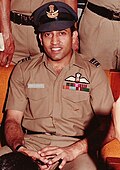 | Rakesh Sharma January 13, 1949 | First Indian in space. | Soyuz T-11/10 (April 3, 1984) | |
| 4 | 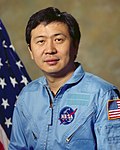 | Taylor Wang June 16, 1940 | ( | First person of Chinese ancestry in space Second Asian American in space, after Ellison Onizuka | STS-51-B (April 29, 1985) |
| 5 |  | Sultan bin Salman bin Abdulaziz Al Saud June 27, 1956 | First Saudi and first Arab in space. | STS-51-G (June 17, 1985) | |
| 6 |  | Muhammed Faris May 26, 1951 | First Syrian in space. | Soyuz TM-3/2 (July 22, 1987) | |
| 7 |  | Musa Manarov March 22, 1951 | ( | First Azeri in space. | Soyuz TM-4 (December 21, 1987) Soyuz TM-11 (December 2, 1990) |
| 8 | Abdul Ahad Momand January 1, 1959 | First Afghan in space. | Soyuz TM-6/5 (August 29, 1988) | ||
| 9 |  | Toyohiro Akiyama July 22, 1942 | First Japanese citizen in space. | Soyuz TM-11/10 (December 2, 1990) | |
| 10 |  | Toktar Aubakirov July 27, 1946 | ( | First ethnic Kazakh in space. | Soyuz TM-13/12 (October 2, 1991) |
| 11 |  | Eugene Trinh September 14, 1950 | ( | First Vietnamese American in space. | STS-50 (June 25, 1992) |
| 12 |  | Mamoru Mohri January 29, 1948 | STS-47 (September 12, 1992) STS-99 (February 11, 2000) | ||
| 13 |  | Talgat Musabayev January 7, 1951 | ( | Soyuz TM-19 (July 1, 1994) Soyuz TM-27 (January 29, 1998) Soyuz TM-32/31 (April 28, 2001) | |
| 14 |  | Chiaki Mukai May 6, 1952 | First Japanese woman and first Asian woman in space. | STS-65 (July 8, 1994) STS-95 (October 29, 1998) | |
| 15 | 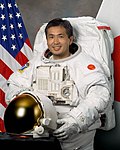 | Koichi Wakata August 1, 1963 | Served on the ISS in Expedition 18, 19, 20, Expedition 38/39 and Expedition 68. | STS-72 (July 11, 1996) STS-92 (October 11, 2000) STS-119/127 (March 15, 2009) Soyuz TMA-11M (November 7, 2013) SpaceX Crew-5 (October 5, 2022) | |
| 16 |  | Kalpana Chawla March 17, 1962 | ( | First Indian American in space. Died on the Columbia. | STS-87 (19 November 1997) STS-107 (16 January 2003) |
| 17 |  | Takao Doi September 18, 1954 | First Japanese spacewalker. | STS-87 (November 19, 1997) STS-123 (March 11, 2008) | |
| 18 |  | Salizhan Sharipov August 24, 1964 | ( | Of Uzbek ancestry. Served on ISS Expedition 10. | STS-89 (January 22, 1998) Soyuz TMA-5 (October 14, 2004) |
| 19 |  | Fyodor Yurchikhin January 3, 1959 | ( | First Georgian in space, of Pontic Greek ancestry. Served on the ISS in Expedition 15. | STS-112 (October 7, 2002) Soyuz TMA-10 (April 7, 2007) |
| 20 |  | Ilan Ramon June 20, 1954 | First Israeli in space. Died on the Columbia. | STS-107 (January 16, 2003) | |
| 21 |  | Yang Liwei June 21, 1965 | First taikonaut from the People's Republic of China. First person launched by an independent spaceflight mission from Asia. | Shenzhou 5 (October 15, 2003) | |
| 22 |  | Soichi Noguchi April 15, 1965 | Served on the ISS in (Expedition 22/23) and (Expedition 64/65). | STS-114 (July 26, 2005) Soyuz TMA-17 (December 20, 2009) SpaceX Crew-1 (November 16, 2020) | |
| 23, 24 |  | Fei Junlong May 5, 1965 | Shenzhou 6 (October 12, 2005) Shenzhou 15 (November 29, 2022) | ||
 | Nie Haisheng October 13, 1964 | Shenzhou 6 (October 12, 2005) Shenzhou 10 (June 11, 2013) Shenzhou 12 (June 17, 2021) | |||
| 25 |  | Anousheh Ansari September 12, 1966 | ( | First Iranian-American in space. | Soyuz TMA-9/8 (September 18, 2006) |
| 26 | 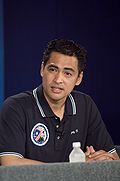 | Sheikh Muszaphar Shukor July 27, 1972 | First Malaysian in space. | Soyuz TMA-11/10 (October 10, 2007) | |
| 27 |  | Yi So-yeon June 2, 1978 | First Korean citizen in space. | Soyuz TMA-11/12 (April 8, 2008) | |
| 28 |  | Akihiko Hoshide December 28, 1968 | Served on the ISS in (Expedition 32/33). | STS-124 (May 31, 2008) Soyuz TMA-05M (15 July 2012) SpaceX Crew-2 (23 April 2021) | |
| 29, 30, 31 |  | Jing Haipeng October 24, 1966 | Shenzhou 7 (September 25, 2008) Shenzhou 9 (June 16, 2012) Shenzhou 11 (October 17, 2016) Shenzhou 16 (May 30, 2023) | ||
 | Liu Boming October 29, 1966 | Shenzhou 7 (September 25, 2008) Shenzhou 12 (June 17, 2021) | |||
 | Zhai Zhigang October 10, 1966 | Shenzhou 7 (September 25, 2008) Shenzhou 13 (October 15, 2021) | |||
| 32 |  | Naoko Yamazaki December 27, 1970 | STS-131 (April 5, 2010) | ||
| 33 | 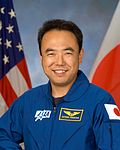 | Satoshi Furukawa April 4, 1964 | Served on the ISS in (Expedition 28/29). | Soyuz TMA-02M (7 June 2011) SpaceX Crew-7 (26 August 2023) | |
| 34, 35 |  | Liu Wang 1970 | Shenzhou 9 (June 16, 2012) | ||
 | Liu Yang 1978 | First Chinese woman in space. | |||
| 36, 37 |  | Wang Yaping January 1988 | First Asian female astronaut to perform a spacewalk (Shenzhou 13). | Shenzhou 10 (June 11, 2013) Shenzhou 13 (October 15, 2021) | |
 | Zhang Xiaoguang May 1966 | Shenzhou 10 (June 11, 2013) | |||
| 38 | 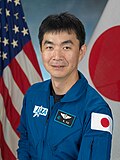 | Kimiya Yui January 30, 1970 | Served on the ISS in (Expedition 44/45). | Soyuz TMA-17M (July 22, 2015) Soyuz MS-11 (August 1, 2025) | |
| 39 |  | Aidyn Aimbetov July 27, 1972 | Soyuz TMA-18M (September 2, 2015) | ||
| 40 |  | Takuya Onishi December 22, 1975 | Served on the ISS in (Expedition 48/49/72/73). | Soyuz MS-01 (July 7, 2016) SpaceX Crew-10 (March 14, 2025) | |
| 41 | 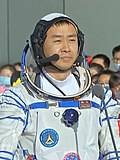 | Chen Dong December 12, 1978 | Shenzhou 11 (October 17, 2016) Shenzhou 14 (June 5, 2022) Shenzhou 20/21 (April 24, 2025) | ||
| 42 |  | Norishige Kanai December 5, 1976 | Served on the ISS on (Expedition 54/55). | Soyuz MS-07 (December 27, 2017) | |
| 43 |  | Hazza Al Mansouri December 13, 1983 | First United Arab Emirates in space. | Soyuz MS-15/12 (September 25, 2019) | |
| 44 |  | Tang Hongbo October, 1975 | Shenzhou 12 (June 17, 2021) Shenzhou 17 (October 26, 2023) | ||
| 45 | Sirisha Bandla 1988 | ( | Virgin Galactic Unity 22 (July 11, 2021) | ||
| 46 |  | Ye Guangfu September, 1980 | Shenzhou 13 (October 15, 2021) Shenzhou 18 (April 25, 2024) | ||
| 47, 48 |  | Yozo Hirano 1985 | Space tourist from Space Adventures First space tourists from Japan First time two Japanese people were launched together. | Soyuz MS-20 (December 8, 2021) | |
 | Yusaku Maezawa 22 November 1975 | ||||
| 49 |  | Eytan Stibbe January 12, 1958 | Space tourist from Axiom Space. First Space tourist from Israel. | Axiom Mission 1 (April 8, 2022) | |
| 50 |  | Cai Xuzhe May, 1976 | Shenzhou 14 (June 5, 2022) | ||
| 51 |  | Zhang Lu November, 1976 | Shenzhou 15 (September 29, 2022) Shenzhou 21/22 (October 31, 2025) | ||
| 52 |  | Deng Qingming March, 1966 | Shenzhou 15 (September 29, 2022) | ||
| 53 |  | Sultan Al Neyadi May 23, 1981 | First United Arab Emirates for long duration mission in space. | SpaceX Crew-6 (March 2, 2023) | |
| 54, 55 |  | Ali AlQarni March, 1992 | First Saudi astronaut to ISS. | Axiom Mission 2 (May 21, 2023) | |
 | Rayyanah Barnawi September, 1988 | First Saudi astronaut to ISS. First female Saudi astronaut in space. | |||
| 56, 57 |  | Gui Haichao November, 1986 | First civilian taikonaut in space. | Shenzhou 16 (May 30, 2023) | |
 | Zhu Yangzhu September, 1986 | ||||
| 58 |  | Namira Salim | First Pakistani in space. | Galactic 04 (October 6, 2023) | |
| 59, 60 |  | Jiang Xinlin February, 1988 | Shenzhou 17 (October 26, 2023) | ||
 | Tang Shengjie December, 1989 | Shenzhou 17 (October 26, 2023) | |||
| 61 |  | Alper Gezeravcı December, 1979 | First Turk in space and to ISS. | Axiom Mission 3 (January 18, 2024) | |
| 62, 63 |  | Li Cong October, 1989 | Shenzhou 18 (April 25, 2024) | ||
 | Li Guangsu July 1987 | ||||
| 64 | Gopichand Thotakura 1993 | First space tourist from India | Blue Origin NS-25 (May 19, 2024) | ||
| 65 | Tuva Cihangir Atasever 1992 | Galactic 07 (June 8, 2024) | |||
| 66, 67, 68 |  | Eiman Jahangir Aug, 1980 | Blue Origin NS-26 (August 29, 2024) | ||
| Ephraim Rabin ? | |||||
| Nicolina Elrick ? | First Singaporean permanent resident in space | ||||
| 69, 70 |  | Song Lingdong August, 1990 | Shenzhou 19 (October 29, 2024) | ||
 | Wang Haoze March 1990 | ||||
| 71 | Chun Wang 1982 | First Asian-born in polar retrograde orbit, [1] i.e., to fly over Earth's poles. | Fram2 (March 31, 2025) | ||
| 72 |  | Amanda Nguyễn October 1991 | ( | First Vietnamese American and southeast Asian American woman astronaut. | Blue Origin NS-31 (April 14, 2025) |
| 73, 74 |  | Chen Zhongrui August, 1990 | Shenzhou 20/21 (April 24, 2025) | ||
 | Wang Jie March 1990 | ||||
| 75 |  | Shubhanshu Shukla 10 October 1985 | An Indian Air Force test pilot and ISRO astronaut, first Indian & South Asian to go to the ISS. | Axiom Mission 4 (25 June 2025) | |
| 76, 77 |  | H.E. Justin Sun 30 July 1999 | Blue Origin NS-34 (3 August 2025) | ||
| Arvinder (Arvi) Singh Bahal 13 October 1945 | |||||
| 78 | Danna Karagussova ? | Blue Origin NS-36 (October 8, 2025) | |||
| 79, 80 | Wu Fei October, 1993 | Shenzhou 21/22 (October 31, 2025) | |||
| Zhang Hongzhang April 1986 |